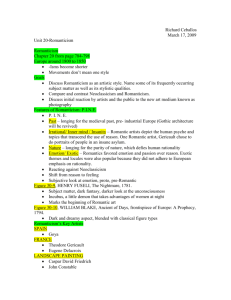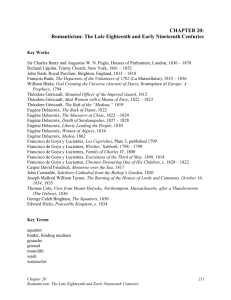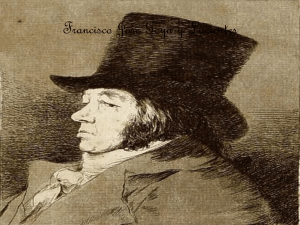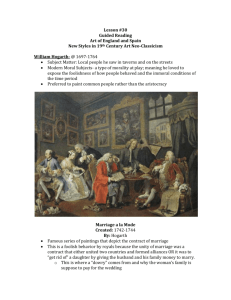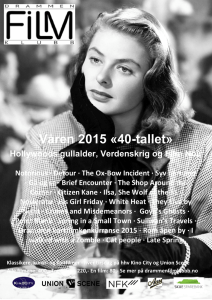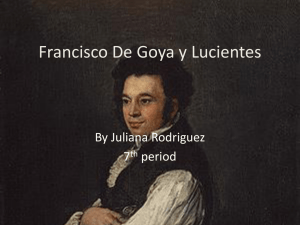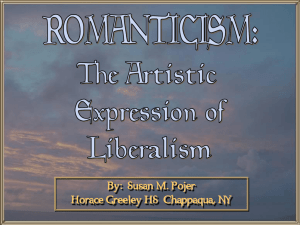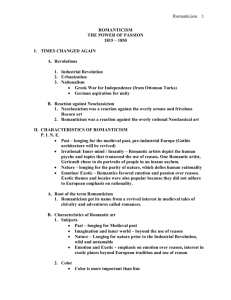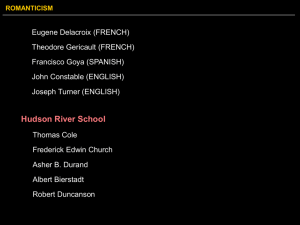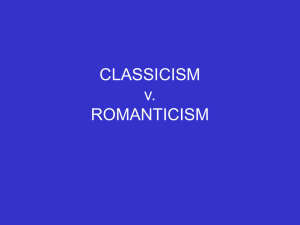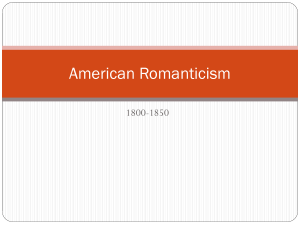Romanticism - Saint John`s High School
advertisement
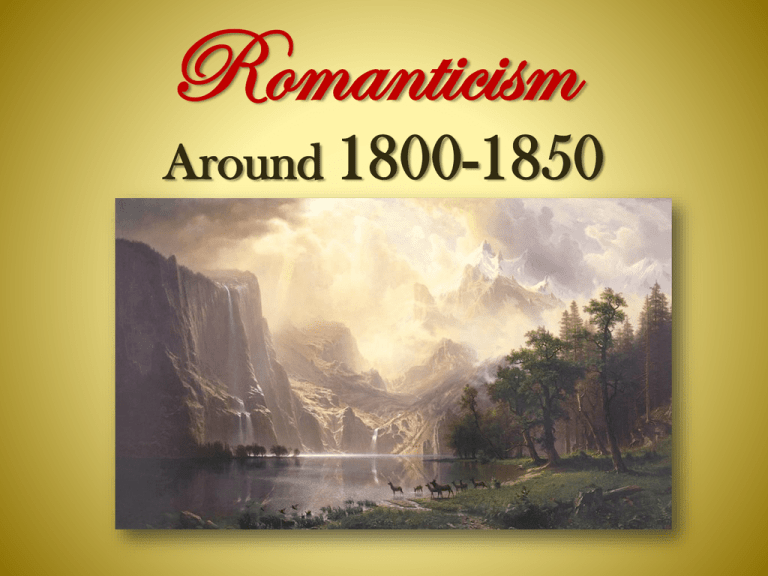
Romanticism Around 1800-1850 Romanticism Rebelling against the Neoclassic period’s Age of Reason, the Romantic era was an Age of Sensibility Romanticism an Age of Sensibility meaning Artists (and writers) chose emotion and intuition over rational objectivity Romanticism Trust your heart, not your head! Romanticism They were about the freedom of individual thought and the ability to express oneself openly. Romanticism These artists also tended to be temperamentalthe troubled genius. Romanticism Got its name from a revived interest in medieval tales called romances- knights in armor, King Arthur… Gothic horror stories were also in vogue- Frankenstein… There was a revival of Gothic architecture An incubus, a demon believed in medieval times to prey on sleeping women, sits on the her. Romantic artists liked to depict the dark terrain of the human subconscious. Big contrast from the more intellectual, rational Neoclassical themes. Henry Fuseli, The Nightmare,1781 Romanticism Goya and Gericault visited insane asylums to use as subject matter. Romanticism New subjects: Grand political canvases The world of the unconscious The awesome grandeur of nature Romanticism Even landscapes were used as political statements Constable=nature against the Industrial revolution Cole=criticism on how Americans were polluting there land John Constable 1776-1837 • English Romantic landscape painter • Sold more paintings in France than in his home land, England • He was never financially successful John Constable • Paints the English countryside as a reaction against the Industrial Revolution which was moving in on it. Painting of the village of Dedham in Essex, 1802 John Constable Vibrant, shimmering paint atmospheric effects Oneness with nature; man is an active participant but does not disturb it. The Hay Wain, 1821 John Constable Oneness with nature; man is an active participant but does not disturb it. Joseph Turner, 1775-1851 • English Romantic landscape painter, and printmaker • Also one of the greatest watercolor landscape painters • known as the “painter of light” • Turner liked extremes in nature: avalanches, sea storms, whirlwinds, etc. John Turner Color is the dominant motif “Warm and cool colors; tall, white, glowing, pale glorious ship of the past contrasted with small, black, modern tugboat of the future” The Fighting Temeaire, oil on canvas.1838 John Turner Color is the dominant motif “Warm and cool colors; tall, white, glowing, pale glorious ship of the past contrasted with small, black, modern tugboat of the future” The Fighting Temeaire, oil on canvas.1838 Romanticism The sublimeAny cathartic experience from catastrophic to intellectual that causes the viewer to marvel in awe, wonder and passion Joseph Turner, The Slave Ship, 1840 Turner, The Slave Ship,1840 The Zong is traveling to the New World and all the slaves die of disease. They were thrown overboard because the insurance co. wouldn’t pay unless they died from a natural calamity. Deeper meaningBloody red sunset humanity/ $= more symbolizing guilt than human life… Joseph Turner, The Snowstorm, 1842 The Hudson River School An American art movement by a group of landscape painters who were influenced by romanticism. They painted the Hudson River Valley, the Catskills, Adirondacks, and White Mountains. . Thomas Cole, Lake Winnipisogee. The Hudson River School Wilderness became a symbol of America’s unspoiled national charactersomething to be proud of. "school" in this sense refers to a group whose style demonstrates a common thread, not a learning institution. Thomas Cole, The Oxbow,1836. The Hudson River School Thomas Cole was the leader. Others included: Frederick Church Asher Durand Albert Bierstadt Thomas Cole, The Oxbow, 1836. Albert Bierstadt, The Rocky Mountains: Lander's Peak, 1863 Frederic Edwin Church, Twilight in the Wilderness, 1860 Frederic Edwin Church, Niagara Falls, 1860 Asher B. Durand, Kindred Spirits, 1849. It depicts the recently deceased painter Thomas Cole and his friend the poet William Cullen Bryant in the Catskill Mountains. The place is idealized. Sold at auction in 2005 to for $35 million, a record for a painting by an American artist. Albert Bierstadt, Among the Sierra Nevada Mountains, California, 1868 Spectacular panoramic views Albert Bierstadt, Among the Sierra Nevada Mountains, California, 1868 Luminism is the emphasis on light- how it changes with time of day Luminism is the emphasis on light- how it changes with time of day Theodore GericaultFrench painter • At 21, a painting prodigy. • He is interested in human psychology He examined the influence of mental state on the face. He made many studies of the inmates at hospitals and institutions for the criminally insane, and he studied the severed heads of guillotine victims. Théodore Géricault, Madwoman with a Mania of Envy Gericault, Raft of the “Medusa” 15 survivors. 2 week ordeal. Cannibalism. His masterpiece. Gericault, Raft of the “Medusa” Shows his commitm ent to social justice. Commemorates a contemporary disaster at sea rather than a heroic example of Neoclassical patriotism. The raft become a floating hell of disease and death. Gericault, Mounted Officer of the Imperial Guard • Compares with David’s Napoleon at Saint Bernard's Pass which like this glorifies equestrian courage. Delacroix His work primarily was concerned with emotions, causes and politics- a reflection of his time. He as other Romantic painters, was not just trying to paint a pretty picture. Delacroix, Liberty Leading the People Revolution of 1830, aiming to overthrow gov’t soldiers. Pyramid. Students, middle and lower classes… Delacroix, Liberty Leading the People Populace united for a common goal Thick brushstrokes; surface textures on the canvas His paintings are characterized by broad sweeps of color, lively patterns, and energetic figural groups Delacroix, Massacre at Chios, 1824 Distant places (Greece’s independence from Turkey), political freedom… Goya He dismisses Neoclassicism. The Sleep of Reason Produces Monsters is an etching. He studied Rembrandt’s techniques . Francisco Goya, The Sleep of Reason Produces Monsters, 1798 Goya This image shows Goya asleep, resting on a table, surrounded by menacing creatures who seem ready to attack. The owls symbolize folly, and the bats symbolize ignorance. Francisco Goya, The Sleep of Reason Produces Monsters, 1798 Goya Francisco Goya, The Family of Charles IV, 1800 Painter to the King in 1786. King Charles IV and Queen surrounded by their children. Goya used his predecessor Diego Velazquez’s Las Meninas as inspiration for the work. Goya includes himself in the rear left of the painting in the act of painting on a large canvas. Goya Velasquez Execution of Spanish rebels after a failed uprising against the occupying French on May 2,1808. Faceless French. Christ-like sacrificial pose. Stigmata on hands. Church, silent and powerless in the distance. Blood soaked figures in foreground Goya, The Third of May 1808, 1814 Francisco Goya, The Third of May 1808, 1814. Goya His later works called the “Black Paintings.” Declining heath contributed to his state of mind, works became increasingly disillusioned and pessimistic. Saturn Devouring One of His Children, 1819 Goya Myth: he is eating his child because of a prophecy that one of them will grow up to be better than he. Symbolism: Human self-destruction Time destroys all its creations A country’s “eating its young in pointless wars.
